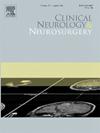Surgical outcomes in high-grade adult type diffuse gliomas (ATDG) with a previous diagnosis of anaplastic astrocytoma without adjuvant therapy
IF 1.8
4区 医学
Q3 CLINICAL NEUROLOGY
引用次数: 0
Abstract
Introduction
Gliomas pose a significant treatment challenge due to their varied genetic makeup and clinical presentations. This study examines a unique cohort of high-grade adult type diffuse gliomas (ATDG) previously diagnosed as anaplastic astrocytoma prior to the WHO 2021 tumor classification changes. This cohort chose to undergo only surgical resection without adjuvant therapies. We provide a rare dataset of patients allowing for new insight into the natural progression of this disease with surgical treatment alone.
Methods
A retrospective review was conducted of patients who were operated on by a single surgeon from the years 2002–2022 and who were diagnosed as having a Grade III Anaplastic Astrocytoma before the WHO 2021 guidelines were published. Correcting for the criteria in the 2021 Guidelines resulted in a mixture of adult-type diffuse malignant gliomas (ATDG), including IDH-Mutant astrocytomas (Grade 3 and 4) and IDH-WT Glioblastoma. All patients included underwent surgical resection alone after declining any adjuvant therapy for various reasons.
Results
A total of 20 patients met the inclusion criteria with an average age of 38 years. Among them, 15 had IDH-mutant (IDH-mt) Grade 3 astrocytomas (75 %), 1 had an IDH-mt Grade 4 astrocytoma (5 %), and 4 had IDH-wildtype (IDH-WT) glioblastomas (20 %). The 5-year survival rate for the entire cohort was 74.0 %. Grade 3 astrocytomas had a 5-year survival of 86.7 %, while Grade 4 astrocytomas and IDH-WT GBM patients exhibited a 5-year survival rate of 40 %. 5-year progression-free survival (PFS) rates were derived from the surgery date up until the recurrence or censorship. The collective cohort had a PFS rate of 34.3 %. Grade 3 astrocytomas achieved a 5-year PFS of 32.0 %, whereas Grade 4 astrocytomas and IDH-WT GBM reached a PFS of 40.0 %.
Conclusion
In our cohort study, we demonstrate that patients with ATDG can potentially achieve relative long-term survival through surgical resection alone. This unique cohort highlights the natural progression of this disease with surgery alone and provides the foundation for future more rigorous studies to evaluate the additive benefit of different adjuvant therapies. With evolving tumor classifications and variable responses to standard therapeutics, it becomes imperative to revisit and understand the additive benefits of different chemotherapeutic protocols in addition to surgical resection.
既往诊断为无弹性星形细胞瘤但未接受辅助治疗的高级别成人型弥漫性胶质瘤(ATDG)的手术治疗效果
由于其不同的基因组成和临床表现,神经胶质瘤提出了重大的治疗挑战。本研究检查了在WHO 2021肿瘤分类改变之前被诊断为间变性星形细胞瘤的高级别成人型弥漫性胶质瘤(ATDG)的独特队列。该队列选择仅行手术切除而不进行辅助治疗。我们提供了一个罕见的患者数据集,允许对这种疾病的自然进展有新的见解,仅通过手术治疗。方法回顾性分析在who 2021指南发布之前,2002-2022年间由单一外科医生手术并诊断为III级间变性星形细胞瘤的患者。对2021年指南标准的修正导致了成人型弥漫性恶性胶质瘤(ATDG)的混合,包括idh -突变星形细胞瘤(3级和4级)和IDH-WT胶质母细胞瘤。所有患者因各种原因拒绝任何辅助治疗后均行手术切除。结果20例患者符合纳入标准,平均年龄38岁。其中idh -突变型(IDH-mt) 3级星形细胞瘤15例(75 %),IDH-mt 4级星形细胞瘤1例(5 %),idh -野生型(IDH-WT)胶质母细胞瘤4例(20 %)。整个队列的5年生存率为74.0% %。3级星形细胞瘤的5年生存率为86.7 %,而4级星形细胞瘤和IDH-WT GBM患者的5年生存率为40 %。5年无进展生存率(PFS)是从手术日期到复发或检查得出的。集体队列的PFS率为34.3% %。3级星形细胞瘤的5年PFS为32.0% %,而4级星形细胞瘤和IDH-WT GBM的5年PFS为40.0% %。在我们的队列研究中,我们证明ATDG患者可以通过单独手术切除获得相对长期的生存。这一独特的队列研究强调了这种疾病仅通过手术的自然进展,并为未来更严格的研究提供了基础,以评估不同辅助治疗的附加益处。随着肿瘤分类的发展和对标准治疗方法的不同反应,重新审视和了解除手术切除外不同化疗方案的附加益处变得势在必行。
本文章由计算机程序翻译,如有差异,请以英文原文为准。
求助全文
约1分钟内获得全文
求助全文
来源期刊

Clinical Neurology and Neurosurgery
医学-临床神经学
CiteScore
3.70
自引率
5.30%
发文量
358
审稿时长
46 days
期刊介绍:
Clinical Neurology and Neurosurgery is devoted to publishing papers and reports on the clinical aspects of neurology and neurosurgery. It is an international forum for papers of high scientific standard that are of interest to Neurologists and Neurosurgeons world-wide.
 求助内容:
求助内容: 应助结果提醒方式:
应助结果提醒方式:


